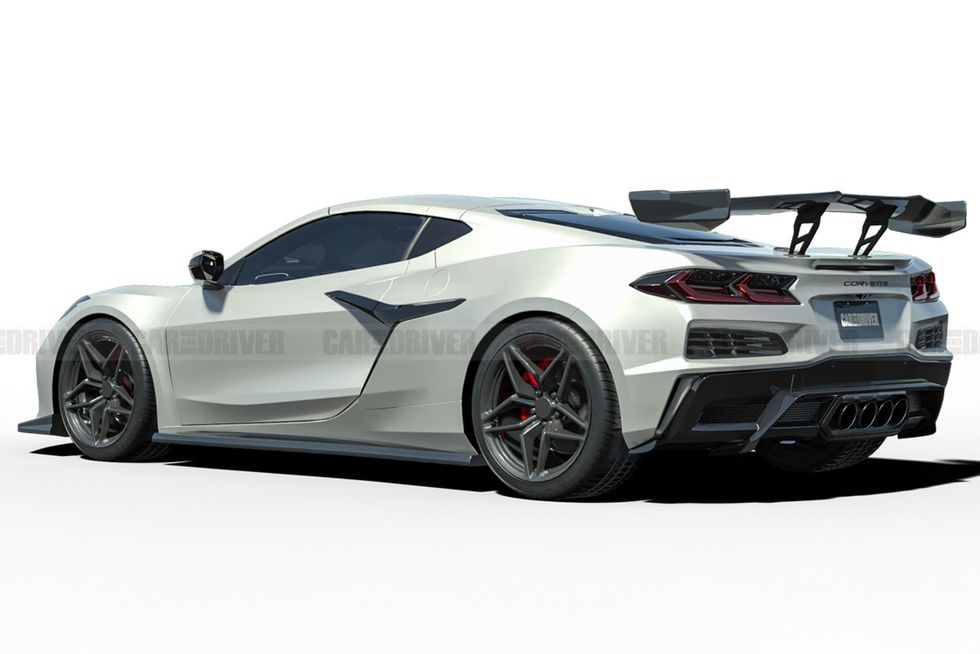From the May 2023 issue of Car and driver.
When the eighth-generation Corvette Stingray arrived for the 2020 model year with its engine behind the passengers and the proportions of a mid-engined Ferrari, a slew of rumors rolled down the road behind it. The Stingray, we heard, would eventually go at the throats of Lamborghinis, McLarens, or anything with the word “hypercar” or “exotic” in its dating profile. Those whispers will become reality in the next two years with the arrival of two high-performance Corvettes: the ZR-1 and the Zora.
Core elements of both cars are currently hidden in plain sight in the 2023 Z06 and the upcoming 2024 E-Ray Hybrid. Both the ZR-1 and Zora use much of the shiny Z06 as a starting point, including the most of its frame and flat-rod V-8, wider body, huge tires and carbon-ceramic brakes. Beyond that, though, the ZR-1 and Zora’s powertrains, performance, and purpose diverge.
The ZR-1
The ZR-1, which we expect to see as a ’25 model, takes those basics and adds firepower in the form of a twin-turbo version of the Z06’s 5.5-liter V-8, supposedly a stonker that beats 800 horsepower.
Like the Z06, the ZR-1 will remain a rear driver. It will likely incorporate active aero elements such as a rear spoiler and front splitter, and offer a Z07-style track package. While its weight will presumably increase by about 200 pounds over a Z06 due to its new turbo components and increased powertrain cooling requirements, we predict the extra kick in its tail will allow it to launch to 60 mph in about 2.5 seconds or less. It will be the fastest Corvette around a circuit and will hold up as comfortably on the street as a Z06. Its performance will put it up against everything from the McLaren 750S to the Porsche 911 Turbo S. But its base price—we estimate it at $150,000—will undercut its competitors by tens or even hundreds of thousands.
The new Top Dog
Fittingly, Chevy will name its new top dog Corvette after its most famous chief engineer, Zora Arkus-Duntov. It was instrumental in dragging the Corvette out of the dark ages of the 1950s by combining high-tech features of the day—disc brakes, fuel injection, an independent rear suspension—with the V-8 power of the red-blooded American. That’s exactly what Zora will do.
Today’s new technology is electrification, and the Zora is a combination of the ZR-1’s mechanicals and the 160 hp electric motor that sits under the nose of the E-Ray. Add the electric power of the E-Ray to the output of the ZR-1 engine and the Zora flirts with 1000 horsepower. It might weigh 4200 pounds, but with all-wheel drive to help launch, it’ll be the Top Fuel dragster in the Corvette lineup; expect it to hit 60 mph in about 1.9 seconds and blast through the quarter-mile in less than 10 seconds at about 150 mph.
However, the Zora will not be aimed at breaking paths; It’ll be a smartly dressed speed demon with a full complement of luxury features and a ride comfortable enough for cross-country jaunts. It will offer typical Corvette value, starting around $200,000. Its power and performance, however, will shoot it into the hypercar stratosphere with more expensive hybrid rockets like the upcoming electrified replacement for the Lamborghini Aventador and the Ferrari SF90 Stradale. A great way to honor Zora’s true legacy.
the legend
Zora Arkus-Duntov is often credited with making the Corvette a world-class sports car. In his 22 years with GM, he worked almost exclusively on the Corvette, becoming the car’s chief engineer in 1967. Arkus-Duntov brought the independent rear suspension, disc brakes, and limited-slip differential to the Corvette. An avid racer, Arkus-Duntov won his class at Le Mans in 1954 and ’55 and set a Pikes Peak record that stood for 13 years in a pre-production ’56 Chevy four-door hardtop.
Director, Buyer’s Guide
Rich Ceppos has evaluated automobiles and automotive technology during a career that has spanned 10 years at General Motors, two stints at Car and driver with a total of 19 years and thousands of kilometers registered in racing cars. He was in music school when he realized what he really wanted to do in life, and in a way, he has achieved it. Between the two of them c/d publications of which he served as executive editor Automotive magazine; was executive vice president of Campbell Marketing & Communications; worked in GM’s product development area; and became editor of Car week. He has raced continuously since college, held SCCA and IMSA pro racing licenses and competed in the 24 Hours of Daytona. He currently owns a 1999 Miata and a 1965 Corvette convertible and appreciates that none of his younger colleagues have yet uttered “Okay, Boomer” when telling one of his stories about the crazy old days at c/d




